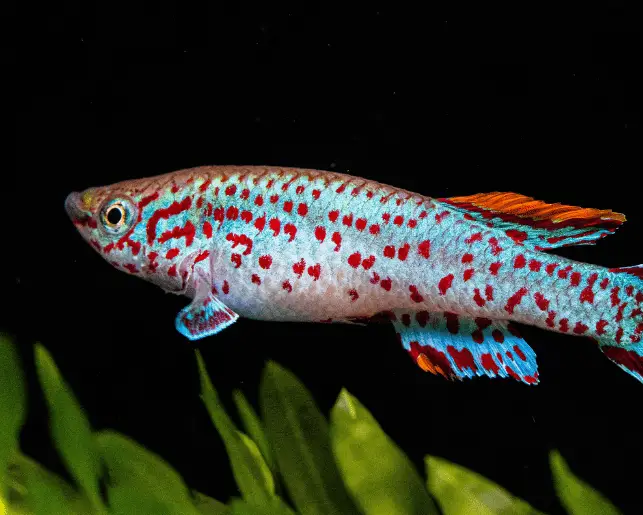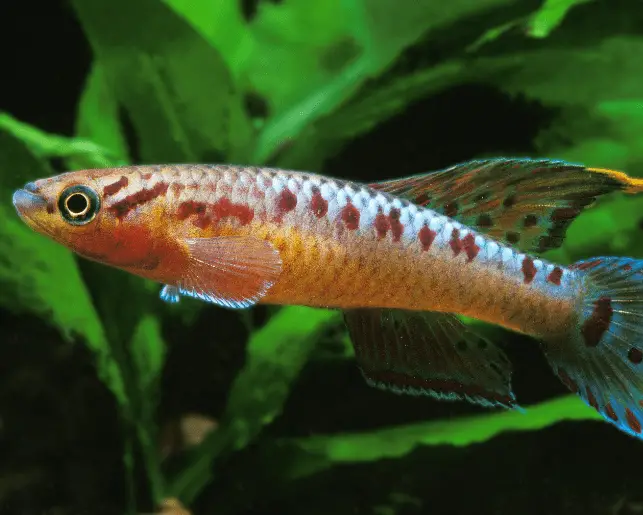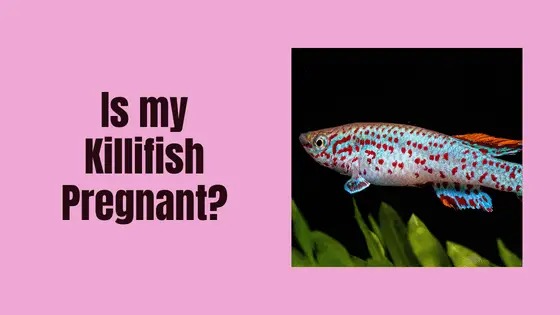Killifish are a popular aquarium fish that come in a variety of colors and patterns. Like many fish, they are oviparous, meaning they lay eggs instead of giving birth to live young. However, it can be challenging to tell if a female killifish is carrying eggs because they don’t have a visible pregnancy like mammals do. In this blog post, we’ll discuss some signs to look out for that may indicate a female killifish is carrying eggs.
An egg carrying killifish’s gravid spot will become bigger and darker as the pregnancy progresses. Her abdomen will also increase in size and develop a boxy shape towards the end of her pregnancy. In addition, her eating habits could change, and she may become aggressive towards other fish before birth.
Female killifish lay their eggs externally in the substrate or on plants, where the males then fertilize them. The eggs typically hatch within a few days, depending on the water temperature.
However, female killifish can carry their eggs for several days before laying them, during which time the eggs continue to develop. This period is often referred to as the “gravid” period. The length of the gravid period can vary depending on the species of killifish, as well as the water temperature and other environmental factors.
In general, the gravid period for killifish can range from a few days to several weeks. Some species of killifish are known for their short gravid periods, such as the turquoise killifish, which can have a gravid period of just 10-14 days. Other species, such as the blue lyretail, may have a gravid period of up to 4 weeks.
How Can You Tell If A Killifish Is Carrying Eggs?
Belly size and shape.
One of the most obvious signs that a female killifish is carrying eggs is a visibly enlarged belly. The belly of a pregnant killifish will appear round and distended, while a non-pregnant fish will have a slimmer, more streamlined shape. However, it’s worth noting that this sign may not always be reliable because some females may be naturally plump or have bloated bellies due to other health conditions.
Changes in behaviour.
Another sign to look out for is changes in behavior. Female killifish may become more territorial or aggressive during breeding season, as they compete with other females for the attention of males. They may also spend more time near the bottom of the tank, as they search for suitable spawning sites. Observing changes in behavior can be a good indicator that breeding is taking place, and eggs may be present.
Male behaviour.
Male killifish play an essential role in breeding, and their behavior can also provide clues about whether a female is carrying eggs. During breeding season, male killifish will often display courtship behavior, such as chasing and displaying their fins to females. They may also be more active and aggressive in defending their territory. Observing changes in male behavior can suggest that a female is carrying eggs and that breeding is taking place.

Appetite.
The next indicator that your killifish is pregnant is her eating habits. She will likely eat more food at first. Then, as her abdomen grows, there isn’t enough space for a lot of food, and she will start eating less.
What Should You Do If my Killifish is Carrying Eggs?
If you observe that your female killifish is carrying eggs or is in the “gravid” stage, there are several things you can do to help ensure the successful hatching and development of the eggs:
- Provide suitable spawning sites: Killifish prefer to lay their eggs in fine-leaved plants, such as java moss or hornwort. Providing these plants in the aquarium can encourage the female to lay her eggs and increase the chances of successful hatching.
- Separate the female: If you want to increase the chances of the eggs hatching successfully, you can separate the female from the male and move her to a breeding tank or a separate section of the aquarium. This will prevent the male from eating the eggs and allow you to monitor the female’s behavior more closely.
Some isolation tanks have a separate compartment for the eggs, like this one. These tanks are ideal for killifish, as the eggs have a safe space to mature where the mother and other killifish can’t eat them.
- Adjust water parameters: Killifish are sensitive to changes in water parameters, so it’s important to maintain stable and appropriate conditions. In general, a pH of around 6.5-7.5 and a water temperature of 72-82°F are suitable for most killifish species. However, specific requirements can vary depending on the species.
- Provide suitable food: During the gravid period, it’s important to provide the female with a varied and nutritious diet to support the development of the eggs. Offer high-quality flake or pellet food, as well as live or frozen foods such as brine shrimp, daphnia, or bloodworms.
- Monitor the eggs: Once the eggs have been laid, monitor them closely to ensure they are developing properly. Remove any unfertilized or diseased eggs to prevent them from contaminating the water.

What To Do When A Killifish Gives Birth.
Once the eggs have hatched, the fry will emerge and begin swimming around the aquarium. At this point, it’s important to take steps to ensure their survival and growth:
- Provide a suitable diet: Newly hatched killifish fry are very small and require small, frequent feedings. Offer them a varied diet of live or frozen foods such as baby brine shrimp, microworms, or liquid fry food.
- Keep the aquarium clean: As the fry are small and vulnerable, it’s important to maintain a clean and well-filtered aquarium to prevent the buildup of harmful toxins.
- Provide suitable hiding places: Killifish fry are vulnerable to predation from other fish in the aquarium, so it’s important to provide them with suitable hiding places, such as plants or spawning mops.
- Monitor water parameters: Keep a close eye on the water parameters, such as temperature and pH, to ensure they remain stable and within suitable ranges for the fry.
- Gradually introduce solid food: As the fry grow and develop, gradually introduce them to solid foods such as finely crushed flakes or pellets.
It’s important to note that not all killifish fry will survive, and breeding killifish can be a complex and challenging process. However, with proper care and attention, you can increase your chances of successfully raising healthy and thriving fry.
This short video shows you signs to indicate your killifish is about to lay eggs.
Conclusion.
In conclusion, it can be challenging to tell if a female killifish is carrying eggs, but there are some signs to look out for that may indicate the presence of eggs. These include changes in belly size and shape, behavior, male behavior, and the presence of a gravid spot. By observing these signs and being familiar with the breeding habits of killifish, you can increase your chances of successfully breeding and raising these beautiful fish in your aquarium.


